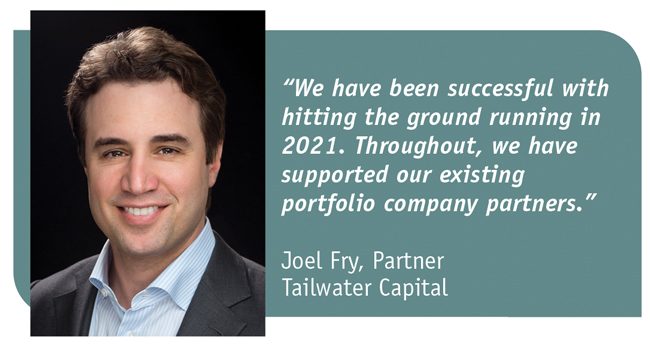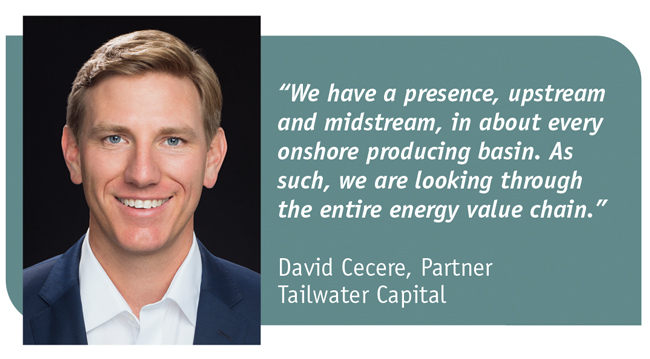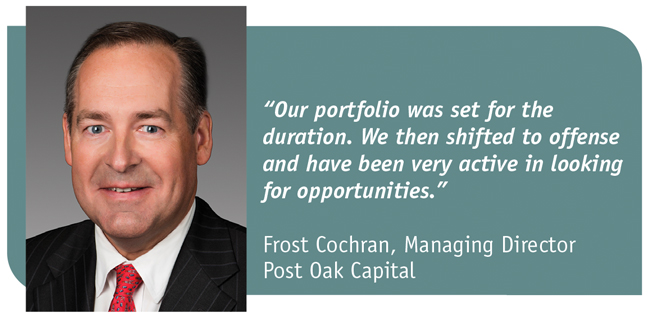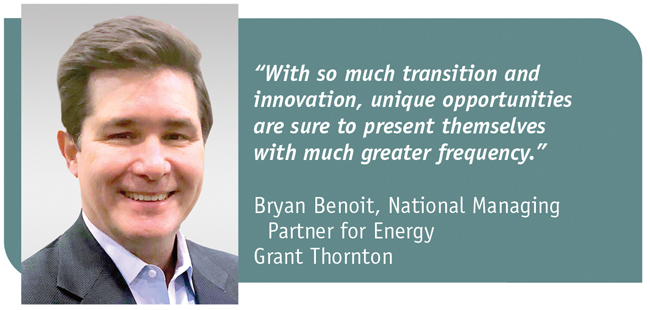Last year was a turbulent one for the upstream sector, with companies reacting to lower commodity prices by slashing capital expenditure and in some cases cutting shareholder pay-outs. That assessment from the February 2021 Energy Council Outlook Survey Report will serve to confirm what U.S. independent producers have seen anecdotally.
Further confirmation came from a recent Westwood survey that indicated the global supermajors intend to cut capital expenditures by a collective $10 billion. Respondents to the Energy Council survey recapitulated the Westwood findings across the value chain. Energy Council found that almost half of respondents have no plans to increase capital expenditure in the next 12 months. Respondents to the survey also warn that capital is being directed to the energy transition.
In September 2020, the Energy Council held a debate focused on the future of exploration. A majority of attendees voted during that debate that exploration would continue, but with a lean away from the majors and toward global independents. The 2021 survey indicated a similar answer, with a majority of small- to mid-cap respondents identifying that exploration still will play a role in their businesses, while the international oil companies predominantly answered in the negative.
“The good news is there is still an appetite to invest in, and finance, oil and gas projects,” notes the Energy Council, a global organization that facilitates connections among senior upstream energy executives and the finance, investment and technology communities. “According to more than 60% of our participants, there is capital available for those who want it. Resource-based lending (RBL) is not dead, and there is a future for private equity.”
Looking in more detail, Energy Council adds that “the capital available is there for top-notch assets only. There is still a healthy pool of investors who continue to see value and significant future upside potential in the upstream sector, but those who will be able to raise it will be those who are successfully able to manage risk, run efficient asset bases and re-evaluate how they are able to create value for investors.”
Believe In The Rock
Lingering challenges and the industry’s uncertain trajectory have left many investors in a bind; however, despite the tough market conditions, Tailwater Capital, a growth-oriented, middle market private equity firm, reports it has continued to perform well, successfully closing its fourth fund in March 2020 and completing a number of acquisitions and add-on transactions already this year. The firm says it has employed several key strategies to position it for success.
“We challenge ourselves to remain patient for the right opportunities, and as a result, several of the recent deals we have completed were done at significant discounts to valuations a year ago,” says Tailwater Capital partner Joel Fry. “We needed to provide legacy financiers the time to work through deals in order to transact, and we feel like we have been successful with hitting the ground running in 2021. Throughout, we have supported our existing portfolio company partners, and when you believe in the rock, it is only a matter of time for the energy market to normalize.”

In addition to patience, Fry explains that aboveground considerations, modest leverage and a diversified portfolio are essential. Tailwater invests in crude, dry and rich gas, natural gas liquids and water. Fry’s colleague David Cecere, also a Tailwater partner, notes that the firm invests in conventional and unconventional development for both upstream and midstream operations. With regard to conventional assets, Cecere says that smaller, private operators are particularly well positioned to profit as assets need increased focus around managing operating costs and efficiencies with a high degree of scrutiny.
“In the larger companies with a mix of conventional and unconventional production, the importance of cost management in conventional can get lost,” Cecere suggests.
That combination of patience and portfolio diversity has yielded results, Tailwater emphasizes. Fry cites crude oil as an example. “Crude had a very difficult second quarter 2020, but dry gas outperformed,” he observes. “If you look at the Haynesville Shale today, for example, there is a tremendous amount of activity.”
Cecere adds, “A portfolio that has operational and geographic diversity is less cyclical. Additionally, we are a lower-middle-market private equity firm with both midstream and upstream assets. We intentionally keep our operating companies on a scale that will be a good fit for multiple potential buyers.”

While patience and portfolio diversification are crucial, they do not tell the full story. Flexibility when it comes to exits and the ability to adapt to the conditions of specific portfolio companies are important as well. “Some portfolio companies grow faster than others, and there can be unique circumstances where we may invest in larger companies, but our strategy is to maximize flexibility,” Cecere elaborates. “We may pursue a sale to a larger public company or even consider an initial public offering depending on what type of exit makes sense.”
There is something to be said about how the overall lending landscape is changing as well. With the onset of the pandemic and natural changes arising within the energy industry, evidence suggests lenders are increasingly cautious. However, according to Fry, some lenders’ total exit from the industry actually has opened new opportunities for Tailwater.
“Tailwater is not overly focused on generating returns by stretching the balance sheet, so we align well with lenders’ interests today by using a modest level of leverage,” he details. “We also have acquired businesses from lenders that don’t want to operate businesses. We can apply equity capital and a management team to take over operatorship.”
There is also a focus on flexibility across the energy landscape, Cecere points out. “We have a presence, upstream and midstream, in about every onshore producing basin in the United States,” he explains. “We have also participated in more than 700 wells through our nonoperated fund and are very active consolidators in the midstream. As such, we are looking through the entire energy value chain.”
Tailwater reports it has started the year strong, acquiring a number of premier and strategically located assets in the first quarter. The firm forges forward with optimism, but not without caution. “We have been successful in securing assets in 2021 because of our team’s work going back to early 2020,” Cecere reflects. “Those valuations would not have won the day a year ago, but we were patient and able to see them through to completion.”
Shifting To Offense
Other capital providers also are practicing prudence. “Our firm was anticipating a pullback in the energy space and prices, but the pandemic accelerated depressed commodity prices and bankruptcies, as well as merger and acquisition activity,” reports Frost Cochran, managing director at Post Oak Capital. “We do not utilize much leverage in our portfolio, but we used late March, April and the first half of May to play defense and make sure our portfolio was set for the duration. We then shifted to offense and have been very active in looking for opportunities.”
Prices have recovered “meaningfully,” he adds, “and we believe that we will continue to see consolidation, which will provide opportunities for our latest fund. We believe Post Oak is in a good position with the amount of dry powder we have to be acquisitive, but also have an existing portfolio that is positioned to generate distributable cash flows for our investor base over the long term.”

Cochran says several management teams are looking for capital. “Long term, if the team is set to develop an asset and manage it, there should be access to capital,” he comments. “The amount of dry powder in the private equity energy sector has declined, and general partners may not be able to raise as much as they have historically, given returns in energy as well as ESG concerns. It will be important to have a complete team that covers all disciplines to access capital as availability is declining.”
He does not anticipate a quick return to eager lending. “Banks are not lending as much capital as they have historically so there is a focus on PDP assets,” Cochran describes. “There will have to be years where the industry shows capital discipline before banks become more aggressive on lending.”
Adapting To Change
The upstream sector has long faced increasing headwinds, and capital flows into the sector have been on a downward trend for some time, the Energy Council notes. “In 2020, the onset of yet another lower-price environment, muted demand and the continuing energy transition disrupted the traditional hydrocarbons investment model even further.”
Reflecting on the results of the survey, Energy Council says that “many private equity players now find themselves with stranded assets and IPOs are off the cards for the foreseeable months ahead. Even long-standing traditional investors who remain bullish in their approach to oil and gas production are diversifying their portfolios to explore potentially more sustainable investments that can be offered in and around green gas; carbon capture, use and storage; and biofuels.”
And yet the upstream sector is adapting. Operating companies are finding ways to recapitalize, diversify and reduce risk. Notably, while limited partners and pension funds are shifting their priorities, “the current lower-price environment presents opportunity and many are poised to swoop in and acquire desirable assets,” according to the Energy Council.
“The current climate may mean a period of creative deal structuring, joint ventures and reduced-risk investment opportunities as the tug of war between renewable and nonrenewable sources of energy continues,” the report suggests. The Energy Council stresses that “in a world with a rapidly growing population, the energy mix will not change overnight, even in the face of hostility.”
One strong positive sign is that the industry is bullish on oil prices, even considering the fact that the survey was conducted at the start of 2021. “Since then, positive news around COVID-19 vaccines, the gradual reduction in U.S. shale production, and the move by OPEC+ to restrain output into mid-2021, and an extra gift from Saudi Arabia to remove another 1 million barrels of oil a day from the market, all provide impetus for West Texas Intermediate (prices),” the Energy Council states.
Many of the survey respondents shared their belief that this trend would continue thanks to demand resurgence. The International Energy Agency shows total demand is expected to increase and slightly exceed 2019 levels by as soon as 2022. On the other side of the ledger, the changing political climate, including the results of the U.S. elections last fall and OPEC+ seemingly resuming its traditional role of managing world prices, point to the likelihood of tighter supply, IEA suggests.
Unique Opportunities
“No one, regardless of their tenure or life experience, had a good waypoint for 2020,” offers Bryan Benoit, national managing partner for energy at global audit and advisory firm Grant Thornton. “No artificial intelligence or predictive data could have been of much assistance in charting any path for how we may have arrived at where we are today in energy, a year later.”
Grant Thornton says it has an advantageous perspective on whether startups can obtain capital to buy distressed assets to build new companies. In that quest, the important elements are proven management teams that put skin in the game and are committed to a long run, according to Benoit.
Putting a finer point on it, Benoit elaborates, “Today, commitment to the long run in energy is relative. Management teams and investors that previously had three-five-year planning horizons will most likely find that time frame will be longer. However, with so much transition and innovation, unique opportunities are sure to present themselves with much greater frequency than the past. Installing a proven management team will undoubtedly increase value by reducing risk and enhancing the likelihood of success. We may find they command a reasonable premium.”
Benoit is circumspect about commenting on banks’ eagerness to lend. “It depends. Commercial banks and lenders may be overextended in oil and gas and we have been able to study this for the past few years. PDP reserves, particularly in lower-cost of production plays such as the Permian Basin, have been most desirable and I do not see much evidence to suggest that is changing. Availability of capital is somewhat constrained, even in the context of PDP. If there will be change in this current phenomenon, it will most likely come in the form of creative and alternative financing. Private equity may lead the way.”
Conventional Opportunities
Several sources note a renaissance in conventional development, a trend that includes capital providers achieving new comfort levels with such projects. “Over the past year, there has generally been greater interest in funding deals for conventional plays,” says Grant Thornton’s Benoit. “One driving force has been that WTI prices generally have been too low and unconventional plays have not been as economical.”

In a December 2020 interview with Yahoo Finance, Benoit suggested a possible oil price recovery during the second quarter of 2021. “With WTI now around $60 per barrel,” he notes, “unconventional may appear considerably more attractive. The question of course is for how long?”
One technique that is currently in favor among producers is to go back to drilled uncompleted wells and bring them on line, he observes. “My family loves duck season, but not this DUC season,” Benoit quips. “My clients see this lasting possibly six-nine months, or well into 2021. Shareholders are looking for earnings, returns and dividends. In the third quarter of 2020, I commented that drilling activity would most likely not reach pre-pandemic levels for two-three years and sitting here now at the end of the first quarter of 2021, that appears to still be the case.”

